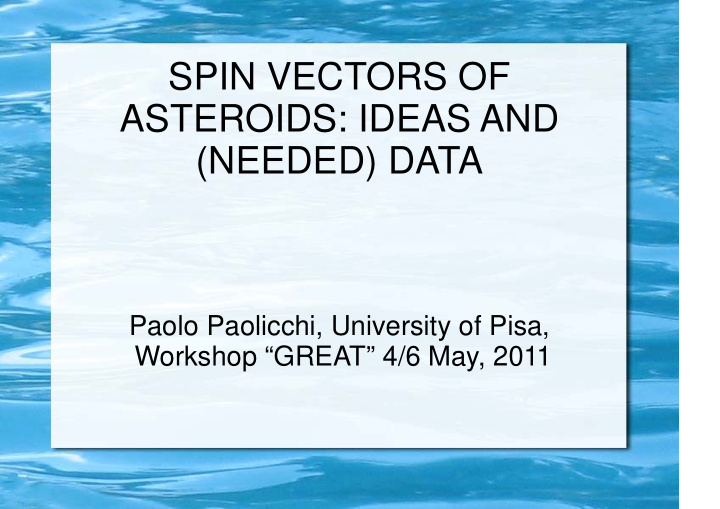



SPIN VECTORS OF ASTEROIDS: IDEAS AND (NEEDED) DATA Paolo Paolicchi, University of Pisa, Workshop “GREAT” 4/6 May, 2011
The relevance of the asteroid spin vector data is now widely agreed. The bare spin data have already shown that the basic “thermalized” model, based on collisionally evolution only, is not working. Relevant features are already present in the 1-D data: V-slope in the region of large bodies, 2 hours limit for bodies larger than about 100m, non maxwellian spin rate distribution for medium sized and small bodies.
The first two issues seem to be a consequence of reaccumulation processes, following a collisional breakup; the third one is more intriguing. No collisional model can explain, in particular, the excess of very slow rotators. Binarity has been suggested, but recently the YORP effect has been identified as the most reliable cause.
Apart the creation of very fast and of very slow rotators, YORP effect (which seems to be effective for bodies smaller than 30-40 km) is also affecting the orientation of the spin axis, which is moved to large angles with respect to the orbital (ecliptic) plane, both prograde and retrograde.
In some cases the clustering of spin axes -affected also by other dynamical processes- can involve the pole longitude also, as seen in the Koronis family (“Slivan asteroids”). YORP is assumed to have no significant effect on large asteroids. YORP-evolved asteroids are more easily moved by the diurnal Yarkovsky effect (families are enlarged); retrograde asteroids are more probably delivered as NEAs.
What do we see? ● Most NEAs are retrograde and often with very inclined axes (YORP+YARKOVSKY, but very poor statistics) ● No significant prograde/retrograde excess in Main Belt with the exception of bodies in the 100 km region (to be explained: limit size for primordial objects, NO YORP...) ● Very few MB asteroids with poles close to the orbital plane......
MOST OF THE OBJECTS IN THE SAMPLE ARE TOO LARGE FOR YORP! Data: in 2007 usable 21 NEAs and 92 MB asteroids. Now the data sample is larger. However, NEAS are 25, only minor changes. The data of MB are more numerous, and several data are going to be included... It seems that the underabundance of poles close to the ecliptic might be mitigated by the next update (AK, p.comm)
NEO latitudes (data 2007)
What do we need? ● NEAS: more data to confirm the relevant issues (clustering of pole latitudes, excess of retrograde asteroids) ● Family asteroids: More poles of family asteroids, to look for other Slivan-like cases ● Main Belt: general: look for the pole/spin distributions of small/medium sized bodies, to verify the consequences of YORP.
Main Belt, general: look for differences between small/medium and large; check the real lack of low-latitude poles among large bodies; in the case: EXPLAIN IT (Some subtle selection effect?) New data are coming (next talk?); those expected from GAIA will be of high quality and affect the ORDER OF MAGNITUDE OF THE DATABASE SIZE: they could allow us to solve the most intriguing open problems.
Recommend
More recommend